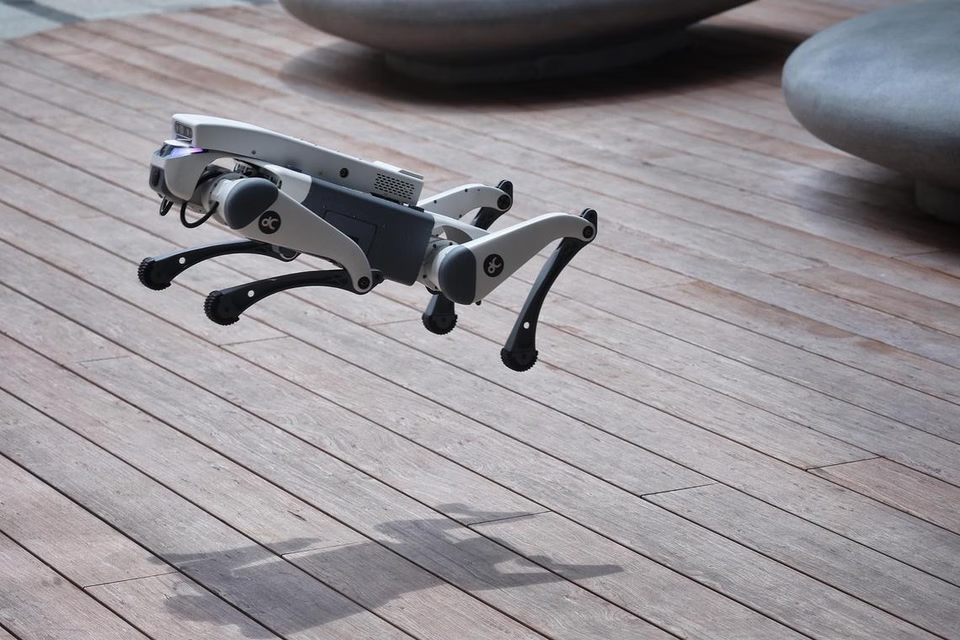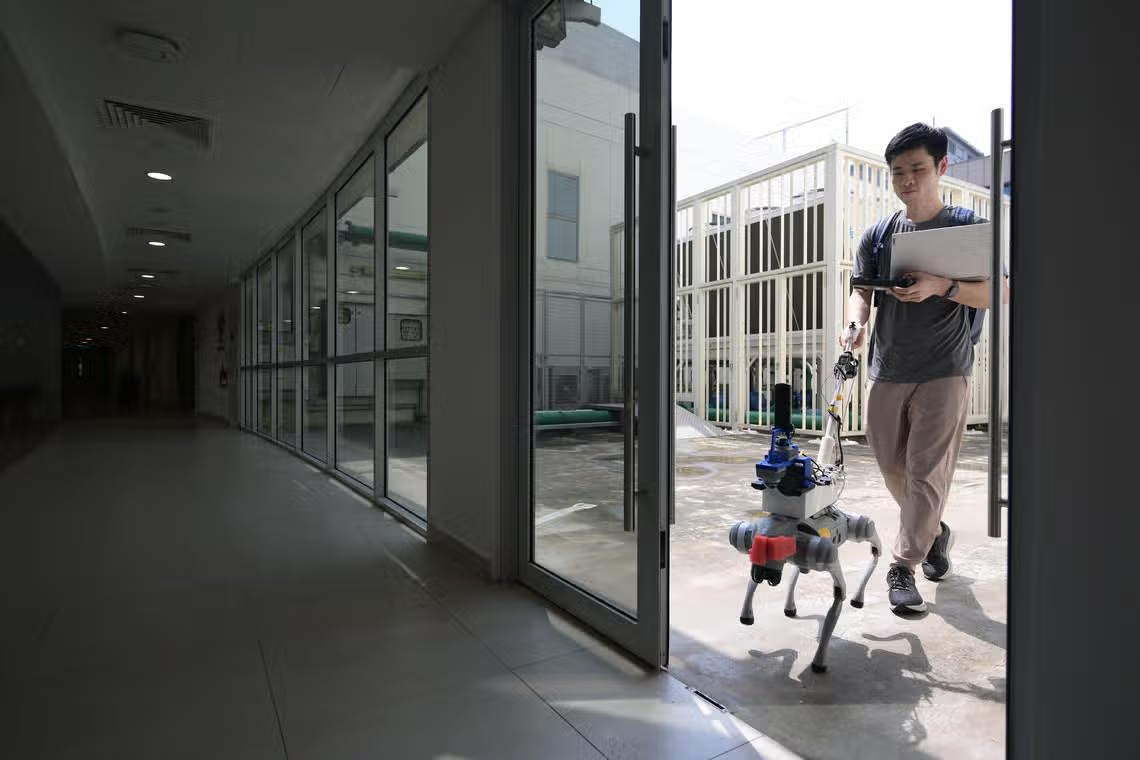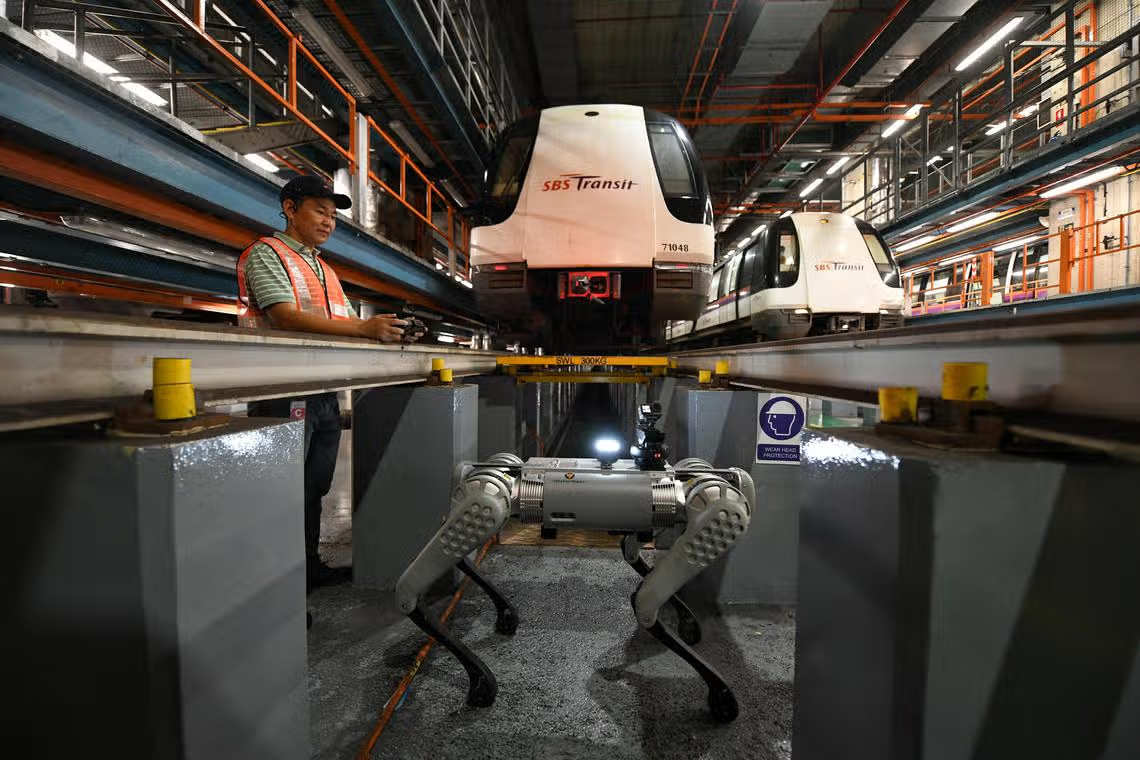May 13, 2025
SINGAPORE – They detect intruders, inspect danger zones and guide the blind.
Robot dogs have found no shortage of work in Singapore – taking on jobs in underground maintenance areas, construction sites and even in social services.
During the Covid-19 pandemic, one such robot dog named Spot was deployed as a safe distancing ambassador in Bishan-Ang Mo Kio Park. More recently, another robot dog accompanied PSP candidate Tony Tan on a walkabout as part of his election campaigning.
The trend here reflects the robot dog’s popularity globally, where more of such devices have been deployed as police dogs, in war zones and even in nuclear plants.
Robot dogs – or quadruped robots – were made popular by Boston Dynamics, a robotics firm spun off from the Massachusetts Institute of Technology, which launched Spot in 2016 after several iterations.
Since then, manufacturers – including several from China – have developed their own versions of Spot, which are often deployed in conditions deemed hazardous for humans.

The trend in Singapore reflects the robot dog’s popularity globally, where more of such devices have been deployed as police dogs, in war zones and even in nuclear plants. PHOTO: THE STRAITS TIMES
In Singapore, National Robotics Programme (NRP) deputy director Chan U-Gene said more companies have deployed robot dogs here, especially for surveillance and inspection operations, amid the strong growth of the robotics sector.
The NRP, which aims to support the robotics industry to boost efficiency, documented more than 300 robotics-related firms in its database, up from around 200 companies in 2023, said Mr Chan.
Although the NRP does not track the number of robot dogs in deployment, he said more firms are exploring the use of the legged forms, which are more mobile and adaptable for various conditions, like stairs and outdoor terrain, compared with standard wheeled robots.
With more manufacturers such as those from China entering the market, robot dogs now cost as little as US$2,700 (S$3,500) – only a fraction of the US$75,000 that Boston Dynamics initially charged.
The Straits Times looks at how robot dogs are being put to work in Singapore.
Guide dogs

Robotics PhD student Cai Shaojun with a robotic dog that has been programmed to guide visually impaired users. PHOTO: THE STRAITS TIMES
Robot dogs are being trained as guide dogs for the visually impaired in trials by the National University of Singapore.
Machines are cheaper and easier to train than real guide dogs and, once the technology is ready, they will be more widely available, said robotics PhD student Cai Shaojun from the NUS Smart Systems Institute, noting the shortage and high cost of assistance dogs.
ST reported in June 2024 that there were only nine active working assistance dogs here, with most of them trained and paired by Guide Dogs Singapore.
Mr Cai said that unlike real dogs, robots can be programmed with artificial intelligence (AI) and image-recognition software to understand sophisticated verbal commands, such as leading a user to a supermarket or other specific locations.
His team has tested robot guide dogs with about a dozen visually impaired users and is training the robots to scale steps and navigate more challenging terrain.
Mr Cai said his team initially considered other forms, including a smart cane with wheels that steers the user away from obstacles and smart-glasses that provide verbal cues. But they ultimately decided that the quadruped design is more useful to visually impaired users, as the four-legged robots are more nimble.
The team plans to pilot the robot guide dogs in more locations like transport hubs and parks to help users navigate these spaces later in 2025.
Another NUS project, led by NUS AI Lab associate director Harold Soh, is building software to program robots to navigate crowded spaces more smoothly by reading social cues.
Watch dogs
Robot dogs have also found jobs as guard dogs. Unlike their real-life colleagues, the robots do not tire and are always alert.
They have patrolled the perimeter fence at Seletar Bus Depot since September 2024, said SBS Transit spokeswoman Grace Wu.
Developed with Weston Robot, the robot named Mars is equipped with high-definition cameras, thermal imaging and other sensors to look out for intruders and signs that the fence has been tampered with, she added.
Security officers can tune in remotely to view what Mars sees through live feeds that stream to a centralised monitoring system.
“Mars’ four-legged mobility enables it to easily navigate grass patches, road kerbs, drains and staircases within the depot environment,” said Mrs Wu. “The pilot results have been promising, and we are studying the feasibility of extending its use to other depots.”
Keeping watch over facilities, robot dogs have come some way since Boston Dynamics’ Spot debuted in Bishan-Ang Mo Kio Park in 2020 to remind park visitors of Covid-19 safe distancing measures.

Spot patrolling Bishan-Ang Mo Kio Park on May 8, 2020, during a pilot trial. PHOTO: THE STRAITS TIMES
Spot was fitted with sensors that estimated the number of visitors in the park, and a speaker to broadcast recorded reminders to observe pandemic measures.
Spot also had a job at the Changi Exhibition Centre community isolation facility, where it delivered medicine to patients with mild Covid-19 symptoms.
Inspector assistants
Robots are also first in line in hazardous locations. SPock, deployed by electricity and gas distribution company SP Group, tags along with inspectors, who check up to 6km of underground tunnels for anomalies.
Equipped with a range of sensors, SPock can identify issues beyond human visual capacity, such as tunnel cracks or dampness.
It allows the human inspectors to take a step back, minimising their exposure to potentially dangerous environments.
SBS Transit has also deployed robot dogs at Sengkang MRT Depot since July 2024 to scan undercarriages for open panels, loose oil tank caps and air leakages that are invisible to the naked eye.
Named Avatar – short for Advanced Video Analytics Train Assessment Robot – the robot inspects the underbelly of trains, freeing up time and reducing some backache for technicians.

SBS Transit’s robotic dog, which can detect anomalies on a train’s underframe, such as missing component parts, was showcased at the Sengkang Depot on May 24, 2023. PHOTO: THE STRAITS TIMES
The robot’s four-legged design is the ideal form for such tasks, as it can efficiently manoeuvre under carriages and climb stairs to inspect the inside of a train, said Mrs Wu from SBS Transit.
She added that SBS Transit is also exploring how robot dogs could be used to detect other issues, such as broken lights or damaged and missing handles.
This technology has been deployed by NUS researchers to inspect the condition of staircases in housing blocks, scanning each step to ensure its height and depth are consistent.
The project is on track to be spun off into a start-up in the coming months, said project lead and senior lecturer Justin Yeoh.


